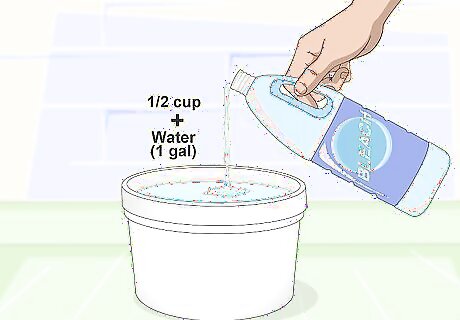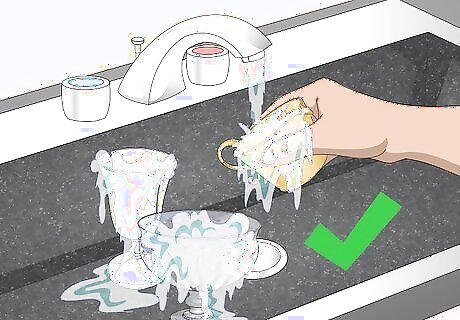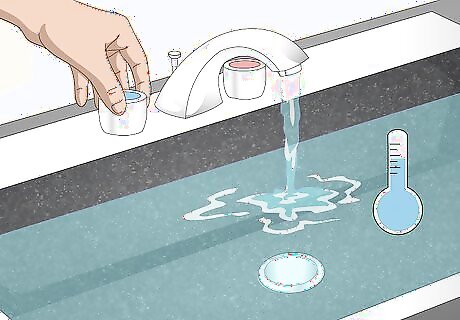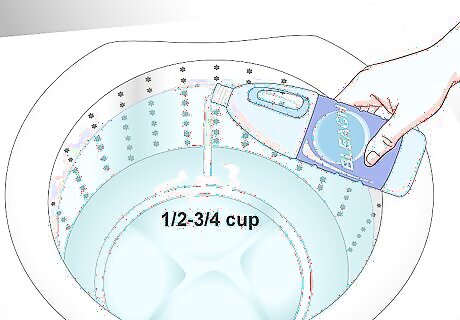
views
Using Bleach as a Disinfectant

Mix 1/2 cup of bleach with 1 gallon of water. When you want to clean non-porous surfaces such as toilets and showers, sinks, and vinyl or tile floors, use a bleach to water ratio of 1:32. Add a half cup (118.3 ml) of bleach to a gallon (3.8 L) of water. Mix this in a sturdy plastic bucket.

Apply the solution to the surface you want to disinfect. Using a mop for floors or a clean rag for other surfaces, carefully dip into the solution and wring the mop or rag out. Wipe the surface in sweeping motions. Go in a back and forth pattern to make sure you cover the whole area. Make sure not to clean with bleach on surfaces like wood, leather, canvas, or carpet. Bleach will stain and fade this type of porous surface.

Rinse the surface with clean, cold water. If you let the bleach solution dry on the surface, it can leave residue. Always use a bucket of clean water, and a clean mop or rag if possible, to completely rinse the surface. A bleach odor may remain in the air after you rinse the surface, which is okay.
Sanitizing Food-Related Items

Wash dishes, silverware, and glasses with soap and water. Bleach is great for sanitizing all kinds of kitchen items, but always wash the items first. Use regular dishwashing detergent and hot water. Scrub the items thoroughly to remove all food residue from them. Rinse the dishes after you wash them.

Fill your sink with cold water. Drain the hot soapy water from the sink. If you have an empty one gallon jug, fill this a couple of times to fill the sink. If you know about how much water your sink can hold, go ahead and run the water straight into the sink. You’ll want to use two to three gallons.

Add one tablespoon (1.8 ml) of bleach per gallon (3.8 L) of water. Use a much weaker solution for items that come into contact with food than you would for other surfaces. One or two teaspoons (5-10 ml) to one tablespoon (14.8 ml) per gallon (3.8 L) of water is the best ratio.

Soak the dishes for two minutes. Place the already-washed dishes into the bleach and water solution. Let them soak for at least two minutes so the bleach has time to sanitize and kill any germs that remain on the items.

Set the dishes in a drying rack to air dry. Never put dishes, glasses, or utensils back in the drawer or cabinet while they are still wet. Leave the items to sit and let the remaining water and bleach evaporate off of them. There’s no need to rinse after the soak.
Using Bleach in Laundry

Test the colorfastness of non-white fabrics. Mix one teaspoon (5 ml) into ¼ cup (59 ml) of water. Apply one drop of the solution to a hidden spot on the fabric. Wait for one minute and then blot the spot dry with a white cloth. If the color does not bleed or fade, it should be safe to use bleach on it. Choose a hem for shirts you tuck in and an inseam or spot around the waist on pants. It’s also smart to check the tags on clothes. There will be a warning if the clothes are sensitive to bleach.

Fill the washer with water. Remember when you add bleach to your laundry not to let the bleach come into direct contact with the laundry. To accomplish this, start the washer before you put any laundry into it. Let the basin fill at least halfway before you add detergent and bleach.

Pour your detergent into the washer. Bleach does not wash clothes, so you still need to use detergent to clean your laundry. If your machine has a detergent compartment, measure out the detergent and add it. If the machine has no detergent compartment, pour it directly into the water.

Add about ½-¾ cup (118-177 ml) of bleach for a standard size load. For small loads, use about ½ cup (118 ml) of bleach. If you have an extra large load, it’s okay to use closer to a full cup (237 ml) of bleach. Pour it into a bleach compartment or directly into the water. Washer sizes and load sizes vary, so you’ll have to adjust how much bleach you use.

Push the laundry down into the water. Let the washer finish filling with water so that the bleach mixes up and dilutes into the water. When the machine is almost full, put your load of laundry into the water. Make sure it goes all the way into the water rather than floating on top.
Working Safely with Bleach

Wear rubber gloves when working with bleach. Chlorine bleach, which is the most common kind, is a strong acid. Bleach will burn your skin if you get it on yourself. Wear gloves that go up your forearm to protect from splashes. Even after you dilute the bleach, it’s best to wear gloves. It's also important to wear protective eyewear whenever you work with bleach.

Work in a well-ventilated room. Just as bleach can burn your skin, it’s also harmful if you breathe its fumes for a long period of time. Open the windows when you can, and set up fans to move the air around. If you have any breathing problems, wear a mask to reduce the intake of fumes, or avoid using bleach altogether.

Pour the bleach over a sink or tub. Undiluted bleach will fade and ruin many different materials. Never pour it over a wood floor or carpet. A stainless steel sink or a plastic wash tub is the best place to dilute your bleach.

Use cold water. If you mix bleach with hot water, you’ll increase the fumes that are released from the bleach. This worsens the already hazardous breathing situation. In addition, hot water decomposes the active ingredient in bleach making it essentially useless.

Avoid using undiluted bleach. Bleach is highly concentrated and is not meant to be used undiluted. Without diluting bleach with water, you’ll likely do more damage than good. Bleach is strong enough to still be effective even in a diluted state. Only use water to dilute bleach. Mixing certain substances with bleach can cause chemical burns, chemical reactions, and dangerous fumes that can lead to serious illnesses.Dilute Bleach Step 18.jpg




















Comments
0 comment